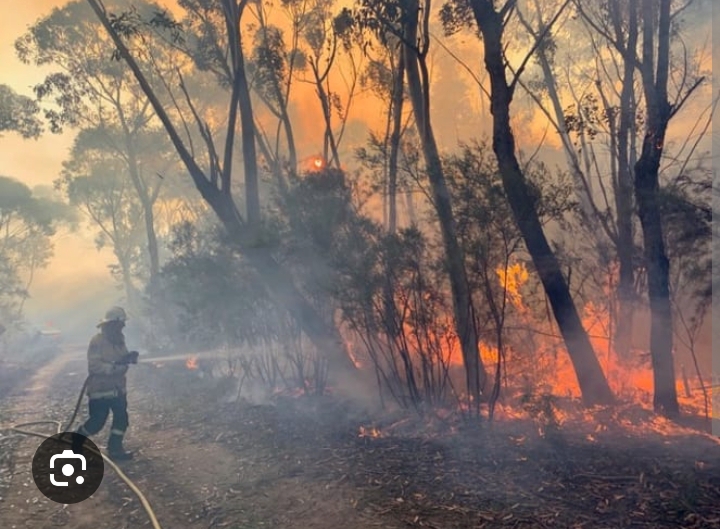Bushfires, also known as wildfires or vegetation fires, are uncontrolled conflagrations that sweep through natural or semi-natural vegetation. While fire plays a natural role in some ecosystems, the increasing frequency and intensity of bushfires, often exacerbated by human activities and climate change, have far-reaching and often devastating consequences. These effects extend beyond the immediate destruction of vegetation, impacting air and water quality, biodiversity, soil health, human infrastructure, and even the global climate. Understanding the multifaceted impacts of bushfires is crucial for developing effective prevention and mitigation strategies.

Effects of Bushfires
Devastation of Ecosystems and Loss of Biodiversity: Perhaps the most immediate and visible effect of bushfires is the widespread destruction of plant life and the habitats they provide. Intense fires can incinerate vast tracts of forests, grasslands, and shrublands, directly killing countless animals, from insects and reptiles to birds and mammals. Even animals that escape the flames often face starvation and predation due to the loss of their food sources and shelter. This habitat destruction can lead to significant declines in biodiversity, pushing vulnerable species closer to extinction and disrupting intricate ecological relationships. For instance, specialized species with limited ranges may be entirely wiped out by a single large fire event.
Deterioration of Air Quality and Public Health Impacts: Bushfires release massive amounts of smoke, particulate matter, and harmful gases into the atmosphere. This smoke plume can travel hundreds or even thousands of kilometers, significantly reducing air quality in affected regions and even distant areas. The inhalation of fine particulate matter (PM2.5) and other pollutants can trigger or exacerbate respiratory illnesses like asthma and bronchitis, cardiovascular problems, and other health issues. Vulnerable populations, such as the elderly, children, and individuals with pre-existing health conditions, are particularly at risk. The economic costs associated with increased healthcare demands and lost productivity due to smoke exposure can also be substantial.
Degradation of Water Quality and Hydrological Changes: Bushfires can severely impact water resources. The loss of vegetation cover leaves the soil exposed and vulnerable to erosion. Subsequent rainfall can wash ash, sediment, and debris into waterways, contaminating drinking water sources and harming aquatic life. Furthermore, the intense heat of fires can alter soil structure, reducing its ability to absorb water and increasing surface runoff. This can lead to increased flooding risks during heavy rainfall events and reduced water availability in the long term, affecting both natural ecosystems and human water supplies.
Damage to Infrastructure and Economic Losses: Bushfires pose a significant threat to human infrastructure, including homes, businesses, power lines, communication towers, and transportation networks. The direct destruction of property results in substantial financial losses for individuals, communities, and governments. Beyond direct damage, bushfires can lead to business disruptions, agricultural losses (destruction of crops and livestock), and reduced tourism revenue. The costs associated with firefighting efforts, emergency response, and long-term recovery and rebuilding can also place a significant strain on national and regional economies.
Impacts on Soil Health and Nutrient Cycling: While low-intensity fires can sometimes play a role in nutrient cycling in certain ecosystems, high-intensity bushfires can have detrimental effects on soil health. The intense heat can sterilize the topsoil, killing beneficial microorganisms essential for nutrient cycling. The loss of organic matter through combustion reduces soil fertility and its ability to retain moisture. This can hinder the regeneration of vegetation and make the affected areas more susceptible to erosion and further degradation. The altered nutrient balance in the soil can also favor the growth of invasive plant species.
Contribution to Climate Change and Feedback Loops: Bushfires release significant amounts of carbon dioxide
Conclusion: In conclusion, bushfires are a complex environmental hazard with far-reaching and interconnected effects. They cause devastating ecological damage, impair air and water quality, threaten human infrastructure and economies, degrade soil health, and contribute to the escalating challenge of climate change. Recognizing the multifaceted nature of these impacts is the first step towards developing comprehensive strategies for prevention, early detection, effective management, and long-term recovery. Addressing the root causes, including climate change and unsustainable land management practices, is essential to mitigating the increasing threat posed by bushfires to both natural environments and human societies.
Leave a Reply